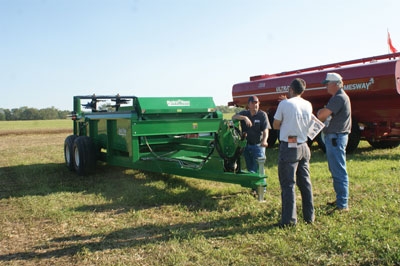
Equipment
Equipment
Manure Handling
North American Manure Expo brings all facets together
November 21, 2012 by Natalie Rector
 With a wide assortment of solid manure spreaders demonstrated in the field, participants could see the adaptation of load cells and how applicators can better control application rates. Sharon Kauk
With a wide assortment of solid manure spreaders demonstrated in the field, participants could see the adaptation of load cells and how applicators can better control application rates. Sharon KaukUniversity of Wisconsin Extension and the Professional Nutrient Applicators Association of Wisconsin teamed up in August 2012 for the North American Manure Expo with a theme of Professional Manure Management. That was a priority for close to 1,000 attendees from 19 states seeking information from commercial exhibitors, professional manure haulers, researchers and extension. Bringing all parties involved in manure together for this one-day event – from farmers to regulators to consultants – is part of an ongoing education and research program at the University of Wisconsin.
Manure pit agitation highlighted new technologies, including dredge boats and hand-held remotely controlled units.
“Pit agitation is the starting point for improving application uniformity that will lead to better crediting of the nutrients,” states Ted Bay, the expo planning chair and the Grant and Lafayette County crops and farm management agent for the University of Wisconsin Extension.
With a wide assortment of solid manure spreaders demonstrated in the field, participants could see the adaptation of load cells and how applicators can better control application rates. Rate control is important to ensure crop yields, to be in compliance with nutrient management plans and for record keeping.
Several educational sessions discussed the cost to haul manure and the impact of that hauling on rural roads. During the demonstrations, a unique hose bridge showed participants how to move manure up and over the road, reducing travel distances for the hauler and creating less disruption of local traffic.
Safety is always a top priority. The manure spill response demo included regulatory comments on expectations for environmental protection and cleanup and an opportunity to remind producers of the preventive measures to avert a spill.
A spill response plan that is documented and well communicated to all family and employees on the farm can avoid or greatly reduce the environmental impacts of an unfortunate manure spill.
Educational sessions brought research and advances in manure management to the forefront, and there was no shortage of relevant issues to be explored. The conundrum of manure management is that, often, solving one condition creates unintended consequences. For example, no-till systems or lower-cost application methods may encourage surface-applied manure. Increasing the time between application and a rain event, as a mechanism to reduce phosphorus losses in runoff, was discussed by Peter Vadas, a research soil scientist with the U.S. Department of Agriculture’s Agriculture Research Service based at the Dairy Forage Research Center in Wisconsin.
Nitrogen management gains the attention of many research projects. Injection or rapid incorporation is well known for reducing odors and losses from ammonia volatilization while other projects discussed how to utilize innovative
low-disturbance application equipment to also maintain surface residues.
Searching for that systems approach that increases nitrogen utilization by the crops, adding value both to the manure application and cropping system while at the same time reducing environmental impact, is the cumulative goal of all farmers and professional manure applicators.
The 2012 Manure Expo was held at the USDA Dairy Forage Research Center Farm in Prairie du Sac, Wis. Additional information on the research and topics related to best management practices with manure handling and application can be found at the center’s website – http://www.ars.usda.gov/main/site_main.htm?modecode=36-55-30-00 – or at the University of Wisconsin – http://www.soils.wisc.edu/extension/manure.php.
Natalie Rector is a manure nutrient management field specialist with Michigan State University Extension.